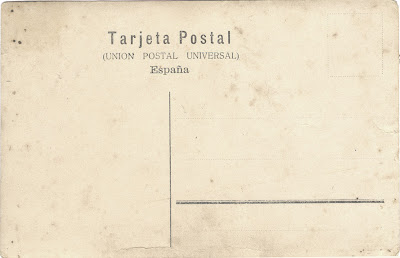Tarjeta postal de 90 x 138 mm, en el anverso aparece un paisaje de playa y vegetación con una persona que traslada al hombro un remo y la leyenda "LA CORUÑA - Paisaje de Mera" por lo que debe de corresponder a la playa de esa pequeña población. La postal aunque está circulada en 1939 debió de ser editada muchos años antes, hacia 1910, probablemente por la Papelería de la Fuente en el Cantón Pequeño nº 13 de La Coruña.
Pero pasemos al contenido de lo escrito que es lo que verdaderamente nos interesa en este caso. El reverso está manuscrito a pluma por Mercedes Rodríguez viuda de Antonio Cobo desde La Coruña a su sirvienta Carmen Valera Moya, a la calle Cananejas de Linares (Jaén) domicilio habitual de Mercedes.
El Texto dice: "!! Viva Franco¡¡ 23-8-1936 (aquí hay una equivocación en el año pues debe de decir 1939 como aparece en el matasellos) . Mi querida Carmen, veo por las cartas de la familia que te acuerdas mucho de mí, yo tampoco te olvido y por eso te pongo estas letras, ahora voy a ver a la Srta. que viene dentro de unos días y luego me marcharé a Linares a últimos de septiembre. Recuerdos a tu familia y para tí un abrazo de tu señorita que no te olvida Mercedes".
Está franqueada con dos sellos (uno está arrancado casi totalmente y otro parcialmente) que fueron editados a partir de 1937, durante la guerra civil española. Aparece la palabra "CENSURADA" impresa con un sello en el lateral derecho, creemos que significaba que había pasado la censura aunque también podría significar que esa tarjeta se censuró por algún motivo (suponemos mejor la primera opción porque la remitente no era sospechosa de estar en contra del régimen porque su marido había sido asesinado al inicio de la guerra en Bailén por el bando republicano).
El matasellos es de la Coruña del 23 de agosto de 1939, significa esto que habían pasado pocos meses desde final de la guerra y por eso se empieza la carta con el !!Viva Franco¡ ¡ que todo el mundo ponía, unos por convicción y otros para evitarse problemas con el régimen recién instalado, época de represión y control de todos los ciudadanos, especialmente los sospechosos de no ser adictos al nuevo gobierno.
El texto de la tarjeta postal es cariñoso y cercano hacia Carmen, que era parte del servicio de la casa de Mercedes, se la escribe a ella de forma familiar y le pregunta por su hermano y si ha encontrado ya trabajo, Carmen no sabía leer y escribir por lo que la carta habría de ser leída por otra persona (este dato aparece en el recorte de prensa).
Estamos reconstruyendo la historia de Carmen y Mercedes a partir de esta postal y de un recorte de prensa, que ponemos al final, de la revista "AMA" (conocida revista de la prensa del corazón dedicada a las amas de casa de la época) de marzo de 1966 donde hay un amplio reportaje sobre Carmen al ser homenajeada por la familia para la que llevaba trabajando 50 años. Empezó a trabajar para los abuelos de Mercedes en 1916 y luego al casarse Mercedes se va con ella y en 1966 seguía trabajando en la misma casa, por ello le hacen un sencillo homenaje y le regalan una medalla de oro de la Virgen del Carmen y el Sagrado Corazón. Por tanto en el año 1939 (año de la tarjeta postal) llevaba ya trabajando para la familia 23 años, de ahí la confianza y el cariño de la misiva entre señora y criada.
Creemos que esta postal nos revela una información valiosa de la época, de las personas, de sus relaciones, etc. Desconocemos el motivo por el que Mercedes se encontraba en Galicia en agosto de 1939, seguramente serían vacaciones con algún familiar, no pensaba volver a Linares hasta septiembre y al parecer ya llevaba algún tiempo allí. Aunque también podría ser que Mercedes hubiera estado viviendo allí durante la guerra, ya que en 1936 fue encarcelada y su marido asesinado, por lo que ahora desconocemos si se marchó temporalmente de Linares que estaba en el bando republicano.
Y dejamos aquí la historia de Carmen y de Mercedes y de esta tarjeta escrita poco tiempo después de haber terminado la Guerra Civil. Os invitamos a leer el texto íntegro del recorte de prensa.
Gracias a mi amigo "Goval" sobrino nieto de Carmen que me facilitó todo el material y sus recuerdos.
Completamos la información de esta historia con una fotografía de la mina "El Correo Linares" donde fueron arrojados los cadáveres de los señores a los que sirvió a nuestra protagonista Carmen Valera, la foto es de principio de los 60 (seguramente el 25 aniversario 1936-1961). ) y se está celebrando una misa en el recuerdo de esas personas.
Complementamos la información de este reportaje con una fotografía de la mina " El Correo Linares" donde fueron arrojados los cuerpos de los señores que servían a nuestra protagonista Carmen Valera, la foto es de principios de los 60 ( probablemente el 25 aniversario 1936-1961 ) y se está celebrando una misa en memoria de aquellas personas.



















































